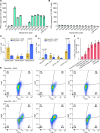Combining STING-based neoantigen-targeted vaccine with checkpoint modulators enhances antitumor immunity in murine pancreatic cancer
- PMID: 30333318
- PMCID: PMC6237485
- DOI: 10.1172/jci.insight.122857
Combining STING-based neoantigen-targeted vaccine with checkpoint modulators enhances antitumor immunity in murine pancreatic cancer
Abstract
Tumor neoantigens arising from somatic mutations in the cancer genome are less likely to be subject to central immune tolerance and are therefore attractive targets for vaccine immunotherapy. We utilized whole-exome sequencing, RNA sequencing (RNASeq), and an in silico immunogenicity prediction algorithm, NetMHC, to generate a neoantigen-targeted vaccine, PancVAX, which was administered together with the STING adjuvant ADU-V16 to mice bearing pancreatic adenocarcinoma (Panc02) cells. PancVAX activated a neoepitope-specific T cell repertoire within the tumor and caused transient tumor regression. When given in combination with two checkpoint modulators, namely anti-PD-1 and agonist OX40 antibodies, PancVAX resulted in enhanced and more durable tumor regression and a survival benefit. The addition of OX40 to vaccine reduced the coexpression of T cell exhaustion markers, Lag3 and PD-1, and resulted in rejection of tumors upon contralateral rechallenge, suggesting the induction of T cell memory. Together, these data provide the framework for testing personalized neoantigen-based combinatorial vaccine strategies in patients with pancreatic and other nonimmunogenic cancers.
Keywords: Cancer immunotherapy; Oncology.
Conflict of interest statement
Figures






Similar articles
-
A bi-adjuvant nanovaccine that potentiates immunogenicity of neoantigen for combination immunotherapy of colorectal cancer.Sci Adv. 2020 Mar 18;6(12):eaaw6071. doi: 10.1126/sciadv.aaw6071. eCollection 2020 Mar. Sci Adv. 2020. PMID: 32206706 Free PMC article.
-
CD137 agonist-based combination immunotherapy enhances activated, effector memory T cells and prolongs survival in pancreatic adenocarcinoma.Cancer Lett. 2021 Feb 28;499:99-108. doi: 10.1016/j.canlet.2020.11.041. Epub 2020 Nov 30. Cancer Lett. 2021. PMID: 33271264 Free PMC article.
-
Advances in personalized neoantigen vaccines for cancer immunotherapy.Biosci Trends. 2020 Nov 4;14(5):349-353. doi: 10.5582/bst.2020.03267. Epub 2020 Sep 10. Biosci Trends. 2020. PMID: 32908077 Review.
-
Anti-pancreatic tumor efficacy of a Listeria-based, Annexin A2-targeting immunotherapy in combination with anti-PD-1 antibodies.J Immunother Cancer. 2019 May 22;7(1):132. doi: 10.1186/s40425-019-0601-5. J Immunother Cancer. 2019. PMID: 31113479 Free PMC article.
-
The Changing Landscape of Therapeutic Cancer Vaccines-Novel Platforms and Neoantigen Identification.Clin Cancer Res. 2021 Feb 1;27(3):689-703. doi: 10.1158/1078-0432.CCR-20-0245. Epub 2020 Oct 29. Clin Cancer Res. 2021. PMID: 33122346 Review.
Cited by
-
Overcoming immunotherapy resistance in non-small cell lung cancer (NSCLC) - novel approaches and future outlook.Mol Cancer. 2020 Sep 11;19(1):141. doi: 10.1186/s12943-020-01260-z. Mol Cancer. 2020. PMID: 32917214 Free PMC article. Review.
-
Safety and Efficacy of Personalized Cancer Vaccines in Combination With Immune Checkpoint Inhibitors in Cancer Treatment.Front Oncol. 2021 May 28;11:663264. doi: 10.3389/fonc.2021.663264. eCollection 2021. Front Oncol. 2021. PMID: 34123821 Free PMC article. Review.
-
Neoantigens: promising targets for cancer therapy.Signal Transduct Target Ther. 2023 Jan 6;8(1):9. doi: 10.1038/s41392-022-01270-x. Signal Transduct Target Ther. 2023. PMID: 36604431 Free PMC article. Review.
-
Peptide-Based Cancer Vaccine Delivery via the STINGΔTM-cGAMP Complex.Adv Healthc Mater. 2022 Aug;11(15):e2200905. doi: 10.1002/adhm.202200905. Epub 2022 Jun 19. Adv Healthc Mater. 2022. PMID: 35670244 Free PMC article.
-
Next-generation immunotherapy for pancreatic ductal adenocarcinoma: navigating pathways of immune resistance.Cancer Metastasis Rev. 2021 Sep;40(3):837-862. doi: 10.1007/s10555-021-09981-3. Epub 2021 Sep 30. Cancer Metastasis Rev. 2021. PMID: 34591243 Free PMC article. Review.
References
Publication types
MeSH terms
Substances
Grants and funding
LinkOut - more resources
Full Text Sources
Other Literature Sources
Medical
Molecular Biology Databases
Research Materials

